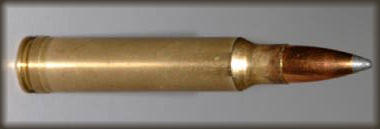

 The Accurate Reloading Forums
The Accurate Reloading Forums  THE ACCURATE RELOADING.COM FORUMS
THE ACCURATE RELOADING.COM FORUMS  Rifles
Rifles  Medium Bore Rifles
Medium Bore Rifles  Sectional Density?
Sectional Density?Go  | New  | Find  | Notify  | Tools  | Reply  |  |
| One of Us |
I am saying that a bullet, ballistic tip or partition, will perform similarly regardless of the game, human or not. Your saying that the bullets perform differently as the game changes, human or what not. Lets not compare human targets to elk or moose. Keep it apples to apples. Captain Finlander | |||
|
| one of us |
Still not the same. alf has always tried to inject Human Mortality Studies into Hunting discussions too. Just not the same. However, if you really think they are the same - "More Power too ya!" - Briscoe Darling. | |||
|
One of Us |
Well....if Alf said it it would have been a six syllable word. At least we can use the word "interject"! /////////////////////////////////////////////////////////////////////////// "Socialism is a philosophy of failure, the creed of ignorance, and the gospel of envy, its inherent virtue is the equal sharing of misery." Winston Churchill | |||
|
| One of Us |
Hey captain! You have to know that a bullet has to penetrate a lot of thick heavy fur, thick skin, and heavy bone. I'm talking about animals not Taliban! Every specie is different in it's toughness as well. I've read of round nose bullets glancing off the heavy skin of tough African game on quartering shots. True? I wonder what a human would have to be wearing to make bullets perform on him the same as game? | |||
|
| One of Us |
I agree to the point but the bullet will want to do what it is intended to do regardless of the medium so the only difference would be the medium. Naturally the terminal results are going to differ between an elk and a whitetail or human but should be consistent with the type of bullet selected. A FMJ is going to make its best effort to pass clean through with minimal deformity and a hollow point is going to start expanding upon impact. Based upon your statement the bullet act differently, I say only as much as the medium. Naturally you can't compare a human to an elk but what or how the bullet attempts to act should be consistent. Captain Finlander | |||
|
| one of us |
Now that you have me "thinking" ( ----- Semper Fi Captain! | |||
|
| One of Us |
your post deals only with terminal performance in game (in an overly simplistic manor) though you are not wrong on the concept of penetration. Not to mention the inertia (energy) acting on the target/game. that energy, that retained inertia is what you are saying doesn't matter. think of this. Imagine you could walk up to a 220lb mule deer and push a 150gr 30cal bullet into the side of his body at a speed of 1 inch per minute. do you think at any second that deer will suddenly go weak and drop to the ground in an INSTANTANEOUS DEATH? NO! it might bleed to death but you wont have a "push-flop tm." effect. sounds stupid right? RIGHT! But my point is, SD is one controllable variable in (mass x speed = momentum) you can make a bullet of "x" weight go faster to effect the amount of energy you put into your target, or you can put a heavier bullet at "x" speed to effect the amount of energy into the target if caliber stays the same. BUT! you are overlooking the effects of SD in bullistics. One of the biggest advantages to SD is that over distance/time when a bullet is moving through a given medium, such as air, the higher the SD the less these forces effect the projectile's speed. SO, at distance, retained speed x mass = retained energy means more energy to be absorbed by the body of the target animal. yes there are some Awesomely preforming bullets these days. but that does NOT make principals of physics just go away! I'll say it again. the principals don't just go away because we have some cool new bullets. but i do agree, if penetration is the ONLY desire, higher SD is not the ONLY way to do that. | |||
|
| One of Us |
Jim, It just depends on how we look at things ... If the argument is that penetration is different with the various .30 caliber bullets with different constructions, but having the same sectional densities, and conclude that SD is meaningless, then we are pulling the concept of SD out of perspective. We just cannot have an equitable appreciation or comparison when we change the bullet material and construction and expect penetration to be the same. It stands to reason that a pure lead bullet vs a thin-jacketed HP bullet vs a thick-jacketed bonded bullet vs a non-deforming monometal Solid bullet have different penetration criteria. Some of the frangible bullets may shatter completely with superficial wounding as a result, whilst the Solid bullet may exhibit a complete pass through, whereas the controlled expansion bullet that mushrooms to a 2.2x of original diameter is found lodged on the far side under the skin of the antelope with a very different wound track. SD is not to be judged in this way. Warrior | |||
|
| One of Us |
I have not read all the posts on this thread but from the several I did read I will say most shooters don't have a grasp of what SD really is. This is how I expain it; If you have a 1/4" diameter rod and cut off a length of this rod 1/2" in length and have someone throw it at your chest as hard as they can, it probably won't penetrate but if you take a section of same rod that is 4'(feet) in length and have that thrown at your chest you will be impaled with it (don't try this). This is a simple explaination of sectional density and a very silly one at that but it shows that SD is very important ingredient for bullet performance on live game and in my mind far more important than bullet construction. Dennis Life member NRA | |||
|
| One of Us |
Wow, first time I've looked back here recently. Okay, one point at a time: "your post deals only with terminal performance in game (in an overly simplistic manor)" SD IS a simplist thing. WE tend to make it more complex by our mental gymnasitics trying to give it more meaning than the simple relationship of mass x diameter SD is. (Lucky and his 1/4" rod simply adds mass but all he says is true, as he states it. But, make the rod of rubber and the difference in construction destroys everything he has built around his monolithic steel rod.) "Not to mention the inertia (energy) acting on the target/game. that energy, that retained inertia is what you are saying doesn't matter." No, what I'm saying is the transfer of that energy varies tremendously because of construction. So SD, per se, means nothing today. "Imagine you could walk up to a 220lb mule deer and push a 150gr 30cal bullet into the side of his body at a speed of 1 inch per minute... deer will suddenly go weak and drop to the ground in an INSTANTANEOUS DEATH? NO! ...SD is one controllable variable in (mass x speed = momentum)" An egg and a golf ball have very nearly the same SD but they sure won't penetrate the same no matter the contact velocity because of the differences in construction. "you can make a bullet of "x" weight go faster to effect the amount of energy you put into your target, or you can put a heavier bullet at "x" speed to effect the amount of energy into the target if caliber stays the same. BUT!" "you are overlooking the effects of SD in bullistics." Not at all. I'm limiting SD to what it is and, from that, what it is meant to convey. Your position, et al, is trying to connect velocity to SD and that's NOT what the phyics is about, terminal energy is a factor of inertia, not weight times cross-sectional area. " One of the biggest advantages to SD is that over distance/time when a bullet is moving through a given medium, such as air, the higher the SD the less these forces effect the projectile's speed. SO, at distance, retained speed x mass = retained energy means more energy to be absorbed by the body of the target animal." You're making SD equal BC and that's wrong. BC and start velocity is what determines retained energy at impact. Neither mass nor diameter, as such, are any part of the BC calculations. "..there are some Awesomely preforming bullets these days." And performance is what SD is supposed to predict. "...but that does NOT make principals of physics just go away!" Sure doesn't. But if we mix widely different pinciples to make a point, the point will have to mean more than the principles and that makes a mess of the physics, does it not? And construction of a projectile is something physics cannot predict simply because it's unpredictable by bullet type and what it encounters in game. Mixing SD and BC and momentum into a mushed whole can help intergrate those effects but doing so is experience based and has NO science behind it. Ergo, today SD - as it's properly defined - has no valid effect on much of anything but monolithics such as cast bullets, which it was intially based on. I simply don't accepth that two bullets of different calibers and mass but identical SD can possibly penetrate the same (which is what SD would suggest) but that's because it totally ignores total mass as a seperate function. But, I do enjoy penerating (pun) exploration of ideas. It helps us better focus on our positions and lets us see things from perspectives we may not otherwise do. I could agree with you guys but then we would all be wrong! Cheers! | |||
|
| One of Us |
Jim, Your assertion as to what SD suggests is wrong. The concept of SD has never claimed to do as you have stated above. Some people that do not know how to interpret SD may think that way, but I have not met such a person in my life. It is more a case of those people who promote light for caliber bullets at higher velocity that trash SD in my experience that I have seen so far. SD cannot be used across a range of different calibers SD cannot be used across a range of different bullet material SD cannot be used across a range of different bullet constructions All the above would be the incorrect use of SD SD can only be used as a significant figure when all is the same - same caliber, same bullet material and same construction. This is so basic that it speaks for itself. SD is relevant in that when you walk into a shop and buy bullets for your 30-06 you consciously make a decision based on SD whether you are going to buy 130 or 150 or 165 or 180 or 200 grain bullets. This decision is based on DISCRIMINATION FOR YOUR INTENDED PURPOSE. This means that when you go hunting small deer at 300 yds you may well pick the 130 grainers, whereas when you go hunting larger game such as elk or moose you may well pick a heavier bullet with more SD as that would be the wise thing to do. This is essentially the value of SD, but there is a lot more to it in terms of bullet performance especially with Soft expanding bullets that is prone to shattering and weight loss and all of this is to be related to a bullet's ideal operating velocity window. Outside this window, and you may find that the bullet does not open up at all, or just partially, and behaves like a solid. On the other end of the scale we will encounter substantial weight loss or total fragmentation with shallow penetration. So SD must be used wisely in the confines of a single caliber. SD is still relevant as it has ever been. Without SD we would not have a bullet. SD is working in all aspects of ballistics and plays a vital part. It works in internal, external and terminal ballistics. The ballistic literature gives credence to the role of SD. Go here for Karl Sellier's findings as published in his book Shusswaffen und Shusswerkungen" http://forums.accuratereloadin...251016441#7251016441 Warrior | |||
|
| One of Us |
Since you asked... Sectional density to me is the mass of a projectile divided by its presented surface area as it penetrates a target. The implications of this are much different than the classic simple formula of bullet weight divided by the square of the bullet diameter. It's different because sometimes the surface area will change due to deformation and even tumbling. Also mass may change because of fragmentation. Possibly mass may be added, as in the case of a hollowpoint bullet becoming clogged. So to me, sectional density is a dynamic concept which may not have a single value. But it is of paramount importance to the penetration event. _________________________ Glenn | |||
|
| One of Us |
Yes, in target behaviour is dynamic - bullets can break-up, tumble, veer off, go straight or be deflected by heavy bone, etc.. Let us take two bullets, say from NF - a Solid and a Soft - both the same weight and SD: a) The NF Solid bullet by its very design in terms of construction, material and geometry (including nose profile) is designed for deep straight-line penetration aided by non expansion and not to veer off course with a mechanism of shoulder stabilization and the mass distribution around it COG point as it stays an oblong projectile that does not deform. b) The NF Soft, a bonded bullet with a solid shank, is designed to expand in a controlled way, expansion is arrested at some point, to make a bigger wound channel, penetrate only about 1/3 of the Solid, but also go straight by another mechanism, being dart stabilization where its COG point shifts closer to the 'Point of Pressure' in the process of becoming shorter by mushrooming. Different design parameters, but the same SD, but different penetration and terminal effect. With the Solid the pristine SD is maintained in target, whereas with the Soft the pristine SD is diminshed in target so it can do its intended work. Warrior | |||
|
| One of Us |
without changing caliber of cartridge, higher SD has more available energy to transfer into your target. Bullet design determines how efficiently said energy is transfered. NOT how much energy is available for transfer. those two factors are controlled by velocity and mass. so higher mass within said caliber IS higher SD. I see you managed to notice that SD and BC overlap each other in some aspects. but they are distinctly different. I wouldn't want you to get more confused. SD is not a direct representation of penetration depth. SD is not as you say "performance is what SD is supposed to predict." you are trying to over simplify it. you are trying to say that SD is irrelevant because you are trying to make SD only for penetration, or only for "performance" which is arbitrary. your statement here quote "I simply don't accepth that two bullets of different calibers and mass but identical SD can possibly penetrate the same (which is what SD would suggest) but that's because it totally ignores total mass as a seperate function." you are ALMOST right. 2 different caliber projectiles of the same SD, design, and construction at the same velocity, same temp same homogenous medium with respectively compensated mass to each projectile (remember for every action there is an equal but opposite reaction) then yes they will most likely penetrate to the same depth. but I don't think you are talking about shooting bullistic gel are you? your comparison to the golf ball having the same SD as an egg. that is true. and obviously getting hit with a golf ball would be worse. but that is only because on impact with the egg its surface fails and its energy is not all absorbed by you (if you are the target) and much of that energy will be missed by the target all together. Freeze the egg and then get hit by both and then tell me what you think. you will still have your similar SD and your different construction. SD is a controllable variable, if you don't want to consider it. then don't SD is one controllable variable in trying to impart through a medium, or on your target. | |||
|
| One of Us |
I think Warrior may have said it better than me | |||
|
| One of Us |
You said it!
Here's something completely independent of SD, I think. Here's how I see it: This is where you have to take a look at the strength of the projectile. The impact. On impact an egg is sure to go splat! because that's what eggs do. They're fragile. In other words their compressive strength is next to nothing. You've encountered a large resisting force which is going to turn the egg a runny yellow mass. The compressive strength of the golf ball is different, of course. It will surely bounce off and maintain its shape. However, neither projectile will likely penetrate. (BTW it hurts like hell to get hit with an egg, even if it does go splat! Ask me how I know! _________________________ Glenn | |||
|
| One of Us |
Here's something completely independent of SD, I think. Here's how I see it: This is where you have to take a look at the strength of the projectile. The impact. On impact an egg is sure to go splat! because that's what eggs do. They're fragile. In other words their compressive strength is next to nothing. You've encountered a large resisting force which is going to turn the egg a runny yellow mass. The compressive strength of the golf ball is different, of course. It will surely bounce off and maintain its shape. However, neither projectile will likely penetrate. (BTW it hurts like hell to get hit with an egg, even if it does go splat! Ask me how I know! that is the same point I made. | |||
|
| One of Us |
Sorry, I see that you did. But it bears repeating I thought. See, when I was a kid some friends and I were going to egg some cars one Halloween and we all ended up getting into an egg fight... Oh, nobody wants to hear the rest. _________________________ Glenn | |||
|
| One of Us |
Ah! no worries I just wanted to make sure someone didn't mistake me. | |||
|
| One of Us |
Increased SD simply means that we put more weight behind the frontal area of the bullet. Momentum is the driver (force) and the frontal area (inhibitor) meets with drag in target. As the frontal area gets bigger, the bigger the drag in target and vice versa. The frontal area that encounters the drag is the wetted surface area, thus the meplat area. Thus if the wetted surface is let us say only 67% (2/3's), like in a non-expanding FN shaped solid bullet, the "effective SD" is scaled up, as we have the same mass behind a now smaller XSA (cross sectional area), encountering less drag in target. And so the manipulation of meplat shape upscales the effective SD, and so SD becomes an important determinant in the penetration event by achieving two more things: a) By giving the bullet a reasonable flat nose meplat, the COG point is moved closer to the front b) The FN nose profile activates shoulder stabilization to prolong straight-line penetration I submit that SD is still not credited with this role by many as explained above. Most still put SD in the very last spot of key variables in the penetration stakes. Some may argue that a monolithic spitzer bullet with the same SD as the monolithic FN bullet will tumble earlier and thus SD is irrelevant, but that has to do with geometry and shape relative to the overturning moment. The overturning moment propensity must thus also be managed by clever design to reach a compromise between a diameter sized flat cylindrical solid bullet and a spitzer solid bullet that is inherently unstable in dense media such as flesh, which is a 1000 times more dense than air. Now turn the spitzer flat-based solid around and shoot it, and you have dart stabilization, as the COG point is now much furher forward than otherwise - same SD, but better penetration. Warrior | |||
|
| One of Us |
I like what I am reading. It is clear that some feel the need to alter criteria to poke holes in the Sectional density philosopy. It is a given that a monolithic bullet offsets to some degree the typical effects of sectional density so the comparing the golf ball to an egg really misses the mark. Like what was clearly stated, all criteria has to be equal in order for a fair comparison to be conducted. The best example of SD that I can think of is using three candles. All three candles are of the same diameter representing one given caliber. Each candle is of a different length representing different bullet weights or sectional density. Light each candle at the same time and track the time it takes for each candle to melt away. A bullet passing through a game animal would similarly expand at a given rate until it passed through, was stopped or desintegrated. Just like the longer candles the higher sectional density bullet will hold up longer as it passes through a game animal leading us to the fact tha there is a functional limit to bullet weights IMO. There is such a thing is to light for caliber to be truely effective. There are always going to be those that get it and those that don't but it is true that the ones that don't usually prefer the lighter for caliber bullet weights. Captain Finlander | |||
|
| One of Us |
It means nothing to me.....squat ________________________________________________ Maker of The Frankenstud Sling Keeper Proudly made in the USA Acepting all forms of payment | |||
|
| One of Us |
Again, to make the candle analogy even close to correct you must propose the construction is the same in each instance and bullets are not candles. I have not suggested the greater mass of a heavy bullet of identitical construction would not penetrate deeper but the construction of bullets is NOT identical, just as the golf ball and egg are not identical, thus their simular SD is meaningless. Large heavy bullets will certainly penetrate deeper than a smaller/ligher bullet of lighter construction but SD isn't the reason, it's mass and how well they each hole together. Given the same SD, a small FMJ will normally penatrate deeper than a larger Nosler BT varmint type bullet inspite of the lower mass of the little one. Trying to project mass as a stand-alone factor is an error. SD is a VERY simple math formula, diameter and mass playing equally, but two calibers can easily have the same SD so once again, SD, as such, has no valid meaning today. In fact, it's so obsolete as to be almost funny! Enough. | |||
|
| One of Us |
Jim, Mass must be given form, take a 500 grain round ball and compare it whith 500 gr bullet made of the same material. Which one will penetrate deeper? When we give mass form, as in above, we increase SD. What does that mean .... we put more mass behind the diameter !!! What is the effect of this? The in target drag will be reduced by virtue of the fact that the diameter has been made smaller for the same mass behind it. Can you see the role of SD at work here? As I mentioned before ... SD cannot be used across a range of different calibers SD cannot be used across a range of different bullet material SD cannot be used across a range of different bullet constructions SD can only be used as a significant figure (a figure of merit), when all is the same - same caliber, same bullet material and same construction. Your analogy of the following is flawed reasoning .... and I quote .... "Given the same SD, a small FMJ will normally penatrate deeper than a larger Nosler BT varmint type bullet inspite of the lower mass of the little one." "An increase in SD leads to less energy transfer to target per unit distance penetrated and thus deeper penetration. The lower the SD the shallower the penetration, the bigger the energy dump to target and the bigger the TC." ....... Karl Sellier (Shusswaffen und Shusswerkungen) Warrior | |||
|
| One of Us |
This here is from the Nitro Express Forum by Bob: Re: Big Bore bullets--sectional density vs velocity [Re: 9.3x57] #149092 - 30/12/09 12:18 PM Sectional density is VERY important! To deny it is to deny that diverse bullet weights for a given caliber have little or no effect on energy, momentum or penetration, because those three are subject to bullet weight which directly determines sectional density for a given caliber. More than that, ballistic coefficient is also directly related to bullet weight in a given caliber. BUT, let's NOT compare cucumbers to tomatoes here (even though they are great together in a salad!). To be fair and honest, we must compare bullets of equal sectional densities that have the same construction AND velocity! It does NO good to compare FN with RN, or softs with solids, or hardcast with monolithics! That's being deceitful, or dumb, to try to garner points in that way. For example: to show that sectional density is meaningful in penetration, we must compare a 450gr Barnes Banded in .458" at max pressure with a 500gr Barnes Banded in .458" at max pressure. At the same velocity is meaningless, in this scenario, as that would slow the 450 down to the level of the 500, so it would not be at max velocity due to not being at max pressure. That's only one example. There are thousands that could be presented where sectional density is very meaningful in terminal ballistics. But, for instance, to compare the penetration of 450gr TSX at normal MV with a 450gr Banded, at normal velocity, when both have identical sectional densities makes no sense, when we already know which one will win that penetration contest. Or, to compare at 180gr TSX in .30-cal at 3000 fps with a 500gr solid in .458" with a FN at 2200 fps, into an elephant.... ???? A good discussion over what makes a good salad would no doubt be more appetizing! Bob | |||
|
| One of Us |
We already know that the Barnes monolithic can penetrate deeper for its weight due to its construction so lets compare the pentrating capabilities of the 150 vs the 168 vs the 180 TSX. The SD number gets larger right along with the weight denoting greater mass. In this comparison which bullet will penetrate deeper? Captain Finlander | |||
|
| one of us |
On paper, they will probably go to very similar penetration depths if fired from the same rifle, say a 30-06, and at similar pressure levels. That is to say if they all expand to similar diameters. If, as is likely in reality, the 180 expands less, it will go deeper than the 150. The same applies to the 168 v the 150. It is not because of the higher SD, it is because of the smaller frontal area that is driven by a similar momentum level in target. On paper, there is less than 5 Lb-ft/s momentum difference between the three out to 500m and, given similar expansion levels, momentum will determine penetration depth. The 150 has the highest energy level, so the wound channel volume will be largest. To 500, the 150 shoots the flattest trajectory, has the shortest time of flight and wind deflection of all three are so close, there is no argument there. So, shot placement with the 150 is easier. One factor is significant. From a 10" twist 30-06, the 150 will be least likely to turn or tumble on impact and it will be most reliable for expansion. SD does not feature when we compare monos. | |||
|
| One of Us |
Captain Finlander, I concur with you, and wish to state that it's not purely SD, and not purely momentum, but the combination of two factors giving us Momentum Density (Mo/Xsa), and as you will see down below SD is embodied in the momentum figure. Also velocity can generally not make up for loss of bullet weight for one, and for another, drag in target goes up to the square of velocity, and so impairs pentration as we have seen with Dr Ashby's tests. Seen this way SD is king. I did a wetpack test at 25 yards with 7 mm bullets in my 7x57 mm Mauser and to minimize the effect of frangible bullets that lose their weight, I decided to use strongly constructed expanding monolithic bullets, which essentially retain all their weight, and so I opted for the Barnes-X bullet that expands to a very even and beautiful mushroom across a velocity range of 2,000 fps to 2,600 fps in wetpacks. Around 2,700 fps it will lose petals and penetration dynamics will then change - so I decided to avoid being too close to this threshold limit. I used 175-gr 7 mm bullets (.284"), and cut 6 mm off the base each time so I could end up with a lot of 175 grainers, 142 grainers and 108 grainers. This represents nice even jumps in lowering the SD. I was guided by Somchem's advice and loaded the 175-gr bullet with 38 grains of S365. For each lower weight I increased the charge with 2.5 grains. For each lower bullet weight I seated the bullet 2 mm deeper so that I could still achieve sufficient purchase on the shortest bullet. This was done to progressively increase the velocity to make up for the loss of bullet weight or SD. Weight .... S365 Load .... AOL ...... Velocity ........ SD .... Penetration 175 gr ....... 38.0 gr ........ 77 mm ... 2,390 fps ... .310 ... 63.0 cm 142 gr ....... 40.5 gr ........ 75 mm ... 2,490 fps ... .252 ... 53.0 cm 108 gr ....... 43.0 gr ........ 73 mm ... 2,610 fps ... .191 ... 42.5 cm It so turned out that as weight was reduced, velocity increased by 100 fps and then by 120 fps. It so turned out that as SD was reduced, penetration depth decreased. All bullets retained 100% of their weight. All bullets expanded to double original diameter. The only parameters that varied were SD and Momentum values. Two shots of each weight were fired to prove the repeatability of the test. As expected, the lighter and faster bullets, penetrated progressively shallower - roughly 10 cm each time. As SD is the ratio of a bullet's weight to its frontal area, it is not the full story as far as penetration is concerned, as the bullet still needs to be put into motion by a force before it could exhibit penetration characteristics. Motion of an object has 2 elements, namely kinetic energy and momentum. I prefer momentum as it gives equal importance to weight and velocity, whereas the energy formula uses velocity to the power of two, and in so doing over emphasizes the importance of velocity. It has been proven that momentum correlated much better with penetration dept. The 'Momentum Density' is actually a better yardstick to get an indication of penetration depth. Momentum being the force applied and the XSA the inhibitor of penetration due to in target drag. It stands to reason that when a greater force is applied to the same frontal area (XSA) of a bullet, it will penetrate deeper. The force (or momentum) gets bigger as the bullet weight goes up in the same caliber as can be seen here: Weight .... Velocity .......... Momentum ......... XSA ........ Mo/Xsa 175 gr ...... 2,390 fps ... 59.750 Lb/Ft-sec ... 0.0807 .... 740.8 142 gr ...... 2,490 fps ... 50.511 Lb/Ft-sec ... 0.0807 .... 626.3 108 gr ...... 2,610 fps ... 40.269 Lb/Ft-sec ... 0.0807 .... 499.3 As expansion of the bullets were all double caliber, I used the original diameter for the calculation of Xsa for simplicity sake. As XSA is related to SD, as shown below, and the momentum value is now engaged in the Mo/Xsa formula, the indicative value is improved. Sectional Density = Mass/Area Momentum Density = (Mass x Velocity)/Area Let us now compare these 3 indexes - SD vs Mo/Xsa vs Penetration Weight .... SD Index ... Mo/Xsa ...... Penetration 175 gr ......... 100 ......... 100 .......... 100 142 gr ......... 81.1 ........ 84.5 ......... 84.1 108 gr ......... 61.7 ........ 67.4 ......... 67.5 One does not have to be a statistician to see the highly positive correlation between the above three parameters. The conclusion is that in our current ballistic system mass is favoured over velocity, and as such a higher SD bullet in a particular caliber will always be the victor. My conclusion is then that sectional density generally assists with deeper penetration, all else being equal, but there are other important considerations as well when bullet shape is varied, such as the bullet material, construction of the bullet, mass distribution around the COG, the nose profile, varying meplats and the medium it is being fired into that can differ - for example paper vs flesh vs steel, etc. 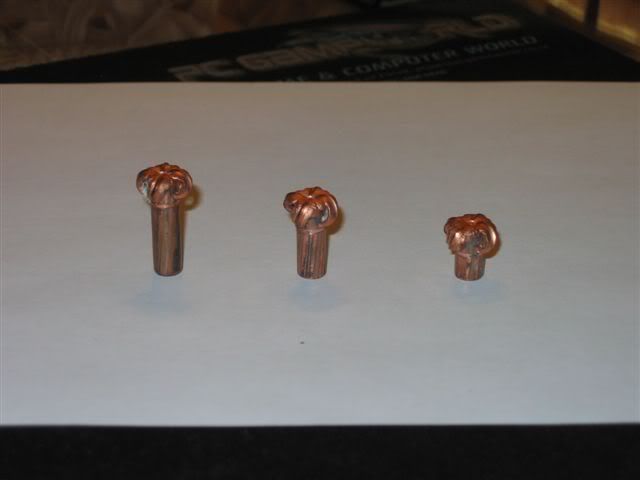 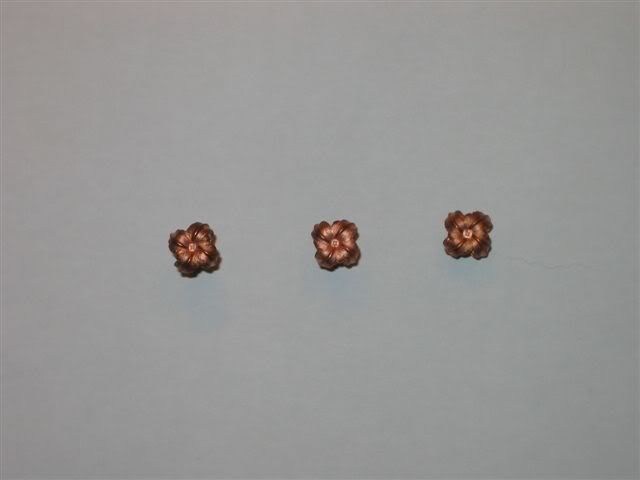 Warrior | |||
|
| One of Us |
Still...nothing ________________________________________________ Maker of The Frankenstud Sling Keeper Proudly made in the USA Acepting all forms of payment | |||
|
| One of Us |
At 2400 fps, which bullet will penetrate more? 300 grain .458 tsx, or 300 grain .375 tsx, and why? | |||
|
| One of Us |
Eny, I think the speed freek pundits who trash SD should be answering this simple question, as you and me actually know the answer. Let us see if we can get a spin on this one. Once we get the spin, we can bet some money. Warrior Warrior | |||
|
| One of Us |
Nice summary, Warrior! Thanks! When I first had a look momentum density, I thought, "This is crap! Just a couple of numbers multiplied together like the TKO, the OGW, somebody's Lethality Index, etc." But I had a closer look and realized that what it gives is a unit of pressure times a unit of time. Then I thought, "Hmm...this is worth a closer look maybe!" _________________________ Glenn | |||
|
| One of Us |
+1 Warrior. Thanks for plugging in the results for the monolithics. It confirms much of what I already new that heavier nomolithics offer no substantial benefit as compared to just the opposite with lead cored bullets. Captain Finlander | |||
|
| One of Us |
With expanding monolithic bullets, such as the Barnes-X, one can afford to shoot lower-SD bullets as they invariable retain 100% of their weight and their petals can withstand much higher impact velocities before failing (around 2,700 fps but may differ per caliber). Some monolithic expanding bullets though loose from 15% to 30%, such as the Lutz Möller bullet, which can be seen here (6.5 mm): 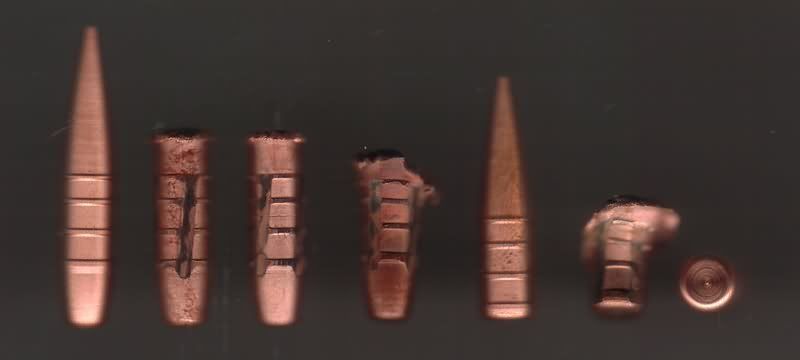 Here is an example of a 220 grain 9,3 mm Lapua Naturalis bullet retrieved from a water tank, MV= 2460 fps, showing very different expansion and weight retention behaviour of up to 100% (the Lapua design will expand reliably and symmetrically without shattering): 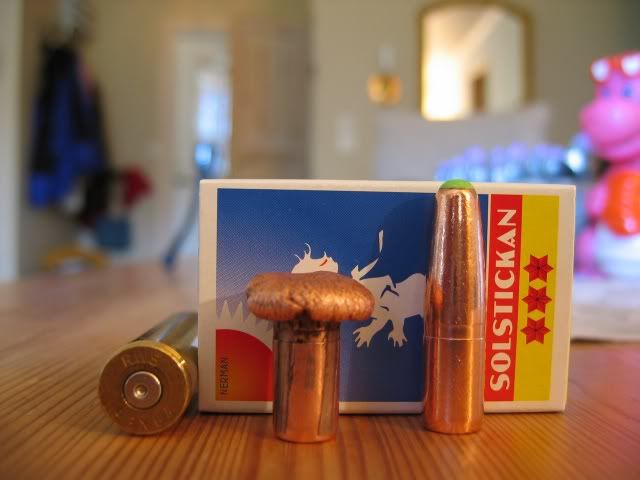 In the context of Soft bullets that lose more weight than a Barnes-X bullet, high-SD bullets ensure much better bullet performance than low-SD bullets. Low-SD bullets at high velocity will invariable impact where the bullet's threshold strength is exceeded and we get bullet break-up. The risk of shattering, material weight loss and lost petals are now becoming a certainty and bullet performance suffers. Very few expanding bullets have such a high velocity window as the Barnes-X or the Northfork Solid Shank bonded bullets, and as such higher SD bullets work in the favour of the hunter. Most other expanding bullets will loose petals long before these two brands. So, extra velocity becomes self-destructive if bullet construction is not taken into account and the various Soft bullets differ greatly - some are more prone to shattering, others are more prone to over expansion, which is just as bad. Here is an example of over expansion of the Norma Oryx bonded bullet - shot at 3,000 fps vs 2,000 fps: 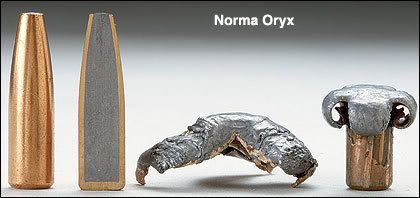 A high-SD bullet (heavier bullet) works in tandem with lower velocity. Keeping the petals intact on expanding Softs is therefore something that we should strive for and that comes with lower velocity so the bullet can stay within its threshold strength. Here is an example of a 9,3/286 gr Rhino bullet retrieved from a Rhino at 10 paces:  The whole idea of premium bond core bullets are to minimize weight loss and to get even and concentric expansion so the bullet can become dart stabilized for straight-line penetration. This has to do with bullet construction, and its purpose is to ensure better terminal momentum preservation to drive the bullet whilst the expanded frontal area creates an effective wound. Controlled expansion bullets create larger wound channels than those unbonded Softs that have their petals pushed flush with their shanks - here we see a Rhino bullet with firm petal standout that cut and crush as intended: 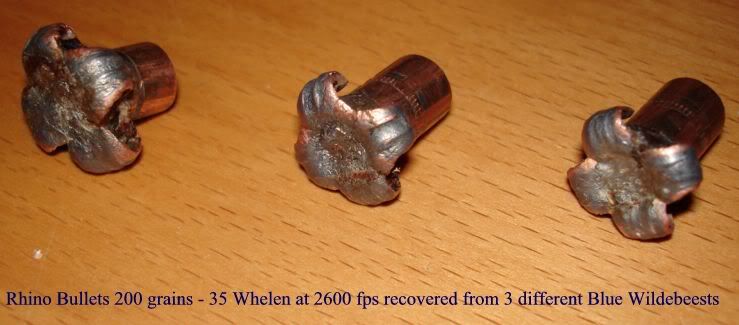 In addition, with high-SD bullets at lower velocity bullet set-up is slower during the first few inches of penetration, and then it blossoms to its full extent where it really counts when it goes through the vital organs, unlike light and fast bullets that lose substantial weight and petals being ripped off in the first 2 or 3 inches. In summary then, an increase in SD leads to less energy transfer to the target per unit distance penetrated, and thus deeper penetration. The lower the SD the shallower the penetration, but the bigger the energy dump cause a bigger temporary cavity. In our ballistic system, a higher SD value comes with more MOMENTUM and less ENERGY and this is the point that Karl Sellier makes, and the important point being that we cannot make up lost momentum with more velocity and achieve the same terminal result. Warrior | |||
|
| One of Us |
I agree and dissiagree with this statement. It falls back to bullet type and game. I do agree in the energy dump part but temporary and permenent wound cavity can be greater with a higher sectional density bullet such as a Nosler Ballistic Tip. The higher SD bullet offers a longer expansion window resulting in greater wound potential which is reflective of the candle comparison. Like the other bullets tested. If the expansion is equal than the difference is made up for in velocity meaning that the higher velocity creates greater hydrostatic shock resulting in a larger wound cavity. This is why the monolithics favor the lighter bullets. Captain Finlander | |||
|
| One of Us |
Different target media, such as water, wet paper, flesh or steel, behaves and reacts differently to a hit by a bullet, as their state of matter is different and thus the drag. So penetration will be different and therefore one type of media cannot mimic the other. All it does is to allow us to compare different bullets in that media. Wet paper is not visco-elastic like muscle, and as such, it makes no temporary cavity and its effects of energy transfer and retardation of the projectile is different. In paper, wet or dry, drag is directly proportional to velocity, not so in flesh. The nature of resistance to penetration (stagnation pressure)in a visco-elastic target (i.e. flesh) of the wetted surface of the bullet is proportional to the square of the velocity. There is a huge difference in the mechanical properties of pure fluid, soft solids (flesh) and hard solids. At high velocity pure water is the "tougher" of the media, next the muscle, and last but not least the paper. The reason for this lies in the mechanical nature of the penetration process in different media based on their state of matter. Also, gelatin does not share similitude in terms of ELASTICITY with muscle, it is a colloid sharing similitude in terms of DENSITY, and if properly constituted and calibrated, it will show similitude with regards to PENETRATION DEPTH, but it does not mimic what the wound in muscle is going to look like, nor how muscle behaves. The expanded tract seen in gelatin does not represent the permanent cavity (PC) seen in muscle, but is in fact an under representation of the temporary cavity (TC) in muscle, as more recent high speed flash radiographs have shown that the TC in muscle is in fact larger than the expanded tract in the gelatin. Thus the bahaviour of the muscle itself cannot be mimicked by the gelatin! What does this mean in practice? It means that if we keep the momentum value the same for two bullets of the same caliber, one light and one heavy, with the same nose shape and wetted area, the faster bullet is going to encounter more resistance to penetration than the slower bullet, and so it's penetration is going to be less than the slower bullet. However, the lighter and faster bullet will dump more energy per unit distance traveled in target, and because the target is visco-elastic, the temporary wound channel is going to be bigger than the slower bullet. We must remember that Mo/XSA is just a simple yardstick and not perfect, as momentum cannot just be made up any way we like, as at extreme ends of the velocity spectrum the increased velocity will experience increased drag by the tune of the 'square of velocity', which is not easily trapped by such a simple statistic across the board, and like wise, if the velocity is so low that it becomes a bump, regardless of bullet mass, then it would not even penetrate skin. So, tissue resistance is greater for the bullet in flesh, the faster the bullet goes. You could demonstrate this phenomenon just by moving your hand through water slowly, and then faster, and you will appreciate the incremental resistance. This increased resistance-force causes bullet failure (rapture or shattering) in soft point bullets, and that is why we get better penetration at lower velocities as the bullet holds together better, thus retaining its momentum better. Here is something I have posted before and I quote: "I came across Dan McCarthy's (500 Grain) very interesting test with 9,3 bullets, shot into elephant at less than 10 yds. The full report can be seen at ... http://bigfivehq.com/softs.pdf The photo I posted previously, comparing the 2 NF's with the Rhino bullet is indeed part of Dan's test. And for ease of reference is posted again here - the Rhini bullet is on the far right:  I re-summarized Dan's results per group; expanding Soft bullets falling in the at 286 grain category, heavy-for-caliber expanding Softs (300 to 320 grains), and lastly expanding Monolithics with very different material properties, so each category could be more equitably compared: 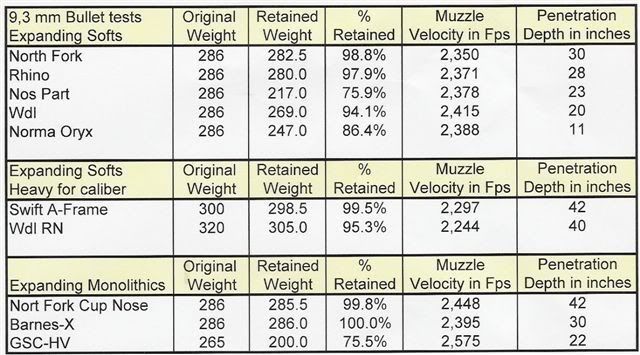 Some comments/observations from the report as per Dan: 1. That the NF Soft is the ultimate bullet in his opinion (open up over a wide range of velocities) - 30 inches. 2. That the sharp petals of the Rhino bullet causes a lot of tearing in the wound channel - 28 inches. 3. The 286 gr Woodleigh bullet tends to over expand outside its velocity window - 20 inches. 4. A number of bullets today outshine the Nosler Partition - 23 inches. 5. The Norma Orxy, also a bonded bullet, only penetrates 11 inches. 6. The 300 gr Swift bullet performed well but tends to foul bores rapidly - 42 inches. 7. The 320 gr Woodleigh bullet penetrated well at 40 inches. 8. The HV bullet would not be his first choice for heavy game (better for medium game at long-range) - 22 inches (Dan showed the bullet as 265 gr when in fact it is actually 260 gr). 9. Barnes-X - 30 inches. 10.NF Cup Nose (expansion very slight) - 42 inches (smaller XSA)." Warrior | |||
|
| One of Us |
One thing to consider is that SD changes with bullets as they expand. Caliber increases, weight usually decreases and so does SD. 465H&H | |||
|
| One of Us |
465H&H, Welcome on board. Quite correct, the pristine SD of a soft expanding bullet will change in target and it is so by design. I am repeating here what I have posted recently, by giving 2 examples: "Let us take two bullets, say from NF - a Solid and a Soft - both the same weight and SD: a) The NF Solid bullet by its very design in terms of construction, material and geometry (including nose profile) is designed for deep straight-line penetration aided by non expansion and not to veer off course with a mechanism of shoulder stabilization and the mass distribution around it COG point as it stays an oblong projectile that does not deform. b) The NF Soft, a bonded bullet with a solid shank, is designed to expand in a controlled way, expansion is arrested at some point, to make a bigger wound channel, penetrate only about 1/3 of the Solid, but also go straight by another mechanism, being dart stabilization where its COG point shifts closer to the 'Point of Pressure' in the process of becoming shorter by mushrooming. Different design parameters, but the same SD, but different penetration and terminal effect. With the Solid the pristine SD is maintained in target, whereas with the Soft the pristine SD is diminshed in target so it can do its intended work." If the Soft is not expanding, it cannot do its best work, which is to greate a bigger and more effective PERMANENT wound channel. The bullet's terminal SD will reduce as a consequence, but it is to achieve the desired effect to be more effective, and that is the very reason why we have expanding Softs. Warrior | |||
|
| One of Us |
I will take that as a yes to my statement that a higher sectional density in relationship to soft expanding bullet types does create a larger wound cavity because of its continued expansion as it passes through tissue. Captain Finlander | |||
|
| One of Us |
The Lutz Möller KJG bullets are light-for-caliber bullets, and here is their 9,3 offering in just 185 grains: 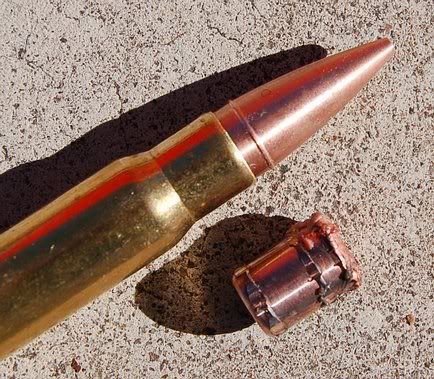 This bullet is way too light for my liking in a 9,3 caliber at only 185 grains, being too short and stubby, it would be too far away from the lands, and it would have a terrible BC. Then the design is such that it would loose plenty of weight on an already light bullet. It appears that the bullet sheds about a 1/3 of its weight, and that would put the effective weight at around 123 grains, turning a 9,3x62 mm Mauser into a 308 Win shooting a 130 grain Barnes TSX bullet, but having a much worse BC. The lower BC is tied to a lower SD of .197 - less weight behind the frontal area. The question now arises how it would compare against the terminal effect of a Barnes-X (or TSX) bullet of say 250 grains, or a 286 gr Rhino, or a 300 gr Swift A-Frame, and whether or not it would really offer any benefits with its higher velocity potential, but with its much greater weight loss propensity. Be it as it may, the choice is yours. Warrior | |||
|
| Powered by Social Strata | Page 1 2 3 4 5 6 7 ... 11 |
| Please Wait. Your request is being processed... |
|

Visit our on-line store for AR Memorabilia

